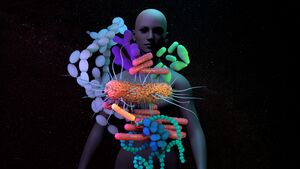The Gut-Brain Axis: The Human Gut Microbiome and Anxiety and Depression
Introduction
By Samantha Lee
Humans have evolved throughout the many years with microbes. Microbes play an important role in not only human health but also human disease. The human intestinal tract contains a wide variety of microorganisms, all of which have a large impact on health and disease [1]. This microbiota has recently been studied more in depth as researchers discovered that microbes have a larger impact on human health than once understood. Antibiotics and diet have been shown to alter the diversity of the gut microbiota, leading to the possibility of irritable bowel syndrome (IBS) and inflammatory bowel disease (IBD) since patients with IBS and IBD have been shown to have unstable gut microbial populations [2].

The human gut contains a large number of microbes that live in the gastrointestinal tract of humans and other animals [53]. These microbes play an important role in digestion, metabolism, and immune function. They can ferment food and supply nutrients and energy to a host and to its immune systems [44]. The intestinal microbiota has a wide diversity of microbial species, and this community of bacteria colonizes the gastrointestinal tract after birth [2]. There are around 40,000 bacterial species that are influenced by vertical transmission from one’s mother, genetic makeup, diet, medications, gastrointestinal infections, and stress [2].
The human gut microbiota can be grouped by three major bacteria enterotypes: Bacteroides, Prevotella, and Runinococcus [9]. Bacteroides are Gram-negative, obligate anaerobic bacteria. They make up a significant portion of the human fecal bacterial population [54]. Prevotella is another Gram-negative bacteria, and it is thought to have a common ancestor with Bacteroides [55]. It is more common in the gut of individuals who eat primarily a diet filled with carbohydrates, since it is able to break down fibers and plant glycans [56, 57]. Ruminococcus, on the other hand, is an anaerobic, Gram-positive bacteria. Certain species of Ruminococcus have been found to be less prevalent in individuals with IBD [58]. Treatment with antibiotics can affect the intestinal gut microbiota and can cause lifelong changes to the makeup of this community.
At right is a sample image insertion. It works for any image uploaded anywhere to MicrobeWiki.
The insertion code consists of:
Double brackets: [[
Filename: PHIL_1181_lores.jpg
Thumbnail status: |thumb|
Pixel size: |300px|
Placement on page: |right|
Legend/credit: Magnified 20,000X, this colorized scanning electron micrograph (SEM) depicts a grouping of methicillin resistant Staphylococcus aureus (MRSA) bacteria. Photo credit: CDC. Every image requires a link to the source.
Closed double brackets: ]]
Other examples:
Bold
Italic
Subscript: H2O
Superscript: Fe3+
Sample citations:
[1]
[2]
A citation code consists of a hyperlinked reference within "ref" begin and end codes.
To repeat the citation for other statements, the reference needs to have a names: "<ref name=aa>"
The repeated citation works like this, with a forward slash.[1]
Mood Disorders
Include some current research, with at least one figure showing data.
Treatments
The Gut-Brain Axis
Include some current research, with at least one figure showing data.
Bifidobacterium
Lactobacillus
Other Evidence
Current Research
Vagus Nerve Stimulation
Conclusion
References
Authored for BIOL 238 Microbiology, taught by Joan Slonczewski,at Kenyon College,2024
